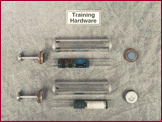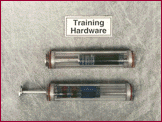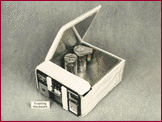




Objectives
The objectives of this experiment were to improve processes used in terrestrial biotechnology or create new biologically-derived products based on the novel scientific insight gained from observing how microgravity affects various functions of living systems. CGBA investigation categories include: protein crystallization, seedling and plant tissue cultures, biomaterials, cell separation, bacterial growth and antibiotic resistance, water purification and biopharmaceutical production.
Shuttle-Mir Missions Approach Results
A wide variety of industry-sponsored research projects were supported by the CGBA payload. All are part of an ongoing program that provides commercial scientists with access to space. Each flight experiment represents a specific step in a process intended to open biotechnology opportunities that derive benefit from the unique environment of space. The Mir Phase 1 Program provided many "lessons learned" which have provided researchers a bridging opportunity to evolve investigations from short-duration Shuttle missions into continuous research carried out onboard the ISS.
Earth Benefits Publications Principal Investigators Co-Investigators![]()
NASA-3, NASA-6
The CGBA payload operations were largely automated. Crew operational activities included transfer to and from Mir and regular periodic status checks. The fundamental component of the CGBA is the Fluids Processing Apparatus or FPA. A FPA is a are test-tube like device that allows controlled, sequential mixing of 2 or 3 fluids in a weightless enviroment. The fluids are contained inside a glass barrel and a LexanTM sheath. The fluids are initially kept isolated from each other by rubber septa which can be moved by depressing the plunger mechanism. A bypass in the glass barrel allows the mixing of a fluid into its adjacent chamber. FPAs are housed in the Group Activation Pack (GAP) which was designed to act as a third level of fluid containment and inititate and terminate sample processing. Eight FPAs can fit into a GAP and 8 GAPs can fit into the incubator for a total of 64 FPAs per payload. This payload architecture allowed for a diversity of biological systems to be studied during each mission including protein crystallization, seedling and plant tissue cultures, biomaterials, cell separation, bacterial growth and antibiotic resistance, water purification and biopharmaceutical production. The CGBA was used on the NASA-3 and NASA-6 missions.
High quality lysozyme crystals exhibited approximately half the mosaicity (level of disorder) of the ground crystals grown on NASA-3; 5 techniques and a single very large (~8mm x 8mm) Granulocyte-Colony Stimulating Factor (G-CSF or NeupogenÆ) grown on NASA-6 were used. Oligonucleotide crystals grown in space diffracted to 0.9 Angstrom units compared to the slightly less ordered ground crystal diffraction of 0.95 Angstrom units. Fungal-fighting abilities of plant seedlings were maintained in microgravity. Iodine resistance of Pseudomonas was observed in space. Aquatic plants, invertebrates and microbes were maintained in a closed system with various morphological and metabolic differences noted in space. No clear pattern of postflight antibiotic resistance was noted, but variations between bacteria and antibiotic combinations suggests efflux pump role.
Space flight provides a unique environment for commercial industries to develop new technologies. Microgravity alters biological processes which can be used to increase understanding of diseases, produce plant derived pharmaceutics, improve treatment for diseases, obtain higher quality protein crystals to design more effective drugs, improve methods for purifying waste water, improvements in bioremediation, enhance crop production, and improve the developments of antibiotics.
Articles appearing in -- Spacebound 97 Proceedings, Microgravity Science and Technology and Current Microbiology
Louis Stodieck, Ph.D.
University of Colorado at Boulder
Sportiello
Tran
Korzun
Cape
Todd
Kundrot
Redman
Doyle
Shoham
Marchin
Urban
Hilaire
Guikema
Li
MacCallum
Manfredi
Juergensmeyer
Juergensmeyer
Kacena
Osslund
Villa
Heyanga
Mahady
Wachtel
Stoner
Clawson
![]()
|
|
Curator:
Julie Oliveaux
Responsible NASA Official: John Uri |
Page last updated: 07/16/1999
.gif)